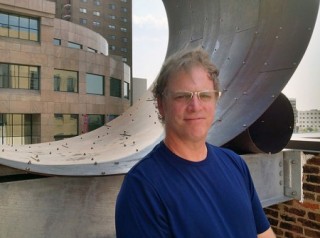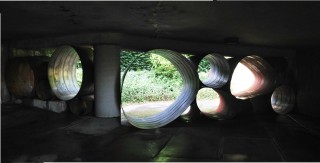
Three huge installations over six weeks, in three different cities. No small task for any artist — but especially one whose work weighs thousands of pounds and has to be hauled by tractor trailer from Colgate’s Paul Schupf Studio in Hamilton, N.Y., to its ultimate destination. The logistics alone could take a creative genius.
And of course there’s the actual art, which can be in development for months or even years.
This summer, Colgate art professor DeWitt Godfrey, along with Chase Jackson ’13, coordinated more than 2,400 miles of travel for 13 days of installation, during a heat wave that, at one point, topped 105 degrees.
They clogged highway traffic with flatbed semis, and intrigued main-street gawkers with gargantuan cranes, lifts, and riggers. Like the pieces they installed, they heaved and gave way in response to the gravity, and pressure, and adjacency of the spaces in which they worked.
First stop: Lexington, Kentucky, for the installation of Concordia, a stack of 15 giant Corten steel cylinders that sits atop the roof of an early 20th-century art deco building on Main St., and leans against the taller wall of the building next door. “Concordia forms a figurative buttress on the roof of the Downtown Art Center,” said Godfrey. “It shoulders the structure as art supports community.”
A story in the Herald-Leader newspaper, and a video by LexArts, the sponsoring organization, described Godfrey’s project as part of the southern city’s goal to become known for world-class public art. Concordia — which weighs 14,000 pounds and took 14 hours to install — was chosen by local citizens from among hundreds submissions and 14 finalists.
Next stop: the renowned Decordova Museum and Sculpture Park in Lincoln, Mass., where it took four days to install Lincoln, the largest work of art ever featured on the property. The 30,000-lb. structure, comprised of 72 cylinders, was commissioned to be a permanent installation.
“Each of my installations respond directly to their site and context, literally and referentially,” said Godfrey. “Lincoln flows down the slope of the landscape, nestled into the side of the hill, quoting the drystack stone walls that define the New England landscape.”
And finally, a 500-mile road trip to Lehman College in the Bronx, where Godfrey and Jackson installed the smallest of the three works. “In and out in 36 hours. A new world record,” Godfrey posted on Facebook. Layman, a long, low sculpture, fits under a pedestrian overpass where, Godfrey said, it blocks and channels some of the light. “It redefines and reframes a marginalized architecural feature.”
Godfrey relied on student help throughout the past two years, in the studio and on the road. Jackson helped with planning, built models and cylinders, helped with all of the installations, and drove the occasional truck.
“Chase brought tremendous initiative, energy, and insight to the fabrication and installation of these projects,” Godfrey said.
“We started as teacher and student, and became colleagues and collaborators. It is hard to imagine how I could have completed this work without him.”


